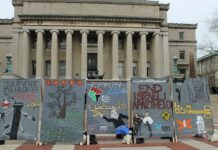
For the better part of four months, NASA scientists in Houston puzzled over an infuriating conundrum. A sleek metal container carried a sample that could shed light on the solar system, and perhaps even more.
But it wouldn’t open.
The disk-shaped container, roughly the size of a small tire rim, was the culmination of an ambitious mission to collect samples from a distant asteroid, Bennu, and return them to Earth. In late September, a NASA spacecraft delivered the container back to Earth after a seven-year journey through space.
“I think people who have seen [the story] in the media, they’re like, ‘It’s just a screw, how hard could it be?’” Salvador Martinez, an engineer who worked on the sample-return mission, told The Washington Post.
Stubborn screws weren’t NASA’s biggest concern when the project began. There were countless ways that the OSIRIS-REx mission – named for the Origins, Spectral Interpretation, Resource Identification, and Security-Regolith Explorer spacecraft that journeyed to the asteroid – could have gone awry before scientists even received the sample and its unyielding container. The spacecraft had a tough assignment: It was launched in 2016 for a seven-year voyage to rendezvous with Bennu, orbit the asteroid, collect a sample from its surface and return home.
Even the return of the Bennu sample was fraught with danger. In a flyby this September, the OSIRIS-REx ejected a return capsule carrying the sample container, which survived reentry and a faulty parachute deployment to land – intact and perfectly upright – in the Utah desert.
So Nicole Lunning, the lead sample curator on the OSIRIS-REx team, expected that the hardest part of the mission was behind her once the capsule was transported to the Johnson Space Center in Houston. One important consideration remained: to ensure that the asteroid samples inside the container were not contaminated by any earthly material. In Houston, the container was kept inside a sealed box around the size of a twin bed. Scientists could only manipulate it by reaching in with gloves through ports built into the box, limiting their range of movement.
“It’s kind of like taking apart a computer with oven mitts,” said Martinez, the mission’s lead engineer.
That shouldn’t have been an issue for Lunning’s team, which had practiced disassembling the capsule inside the box. In October, they took on the real thing. One by one, scientists removed the bolts holding the capsule together. Toward the end of the process, they came across two fasteners, less than an inch long, that not only wouldn’t budge but began to deform the scientists’ tools.
Lunning’s team was still able to gather around 70 grams of dust and rock by reaching into parts of the container with tweezers and scoops – enough to exceed the mission’s goal of 60 grams. But the bulk of the sample was stuck inside.
Martinez was called in to help with the disassembly. His team puzzled over the stuck fasteners and the limitations posed by the container’s quarantine in a sealed box. The space was too small for large tools; a lubricant for the screws could have contaminated the samples.
By January, the engineers built an oblong metal clamp that attached to the container’s rim, which allowed an operator to lower a screwdriver-like head onto the fastener. On Jan. 10, they turned the knobs carefully until – finally – the screws budged. Once the lid was removed, several scientists posed holding the metal clamp while a colleague cheered – “Let’s go home!”
“It’s hard to put in words how much it meant to our team,” Martinez said.
NASA has yet to announce the total sample mass recovered from Bennu, Lunning said. Every gram will aid research about the composition of the solar system’s earliest asteroids and the building blocks of life, she said.
Martinez said the team will try to diagnose why the two fasteners became stuck, research that could help NASA engineers learn more about how their components fare on long space voyages. For now, they’ll marvel at how a priceless asteroid sample was saved by the invention of a very elaborate screwdriver.
“We’ll be ready for other missions when [they] happen,” Martinez said. “Until then, there’s a lot of celebrating that we’ll do.”
(c) 2024 , The Washington Post · Daniel Wu












NASA, the CDC, FDA, Big Pharma seem to be the same crooks but the CDC, FDA and Big Pharma are more dangerous and have the blood of millions of people on their hands.
It adds more meaning to the expression: I’m not a rocket scientist.